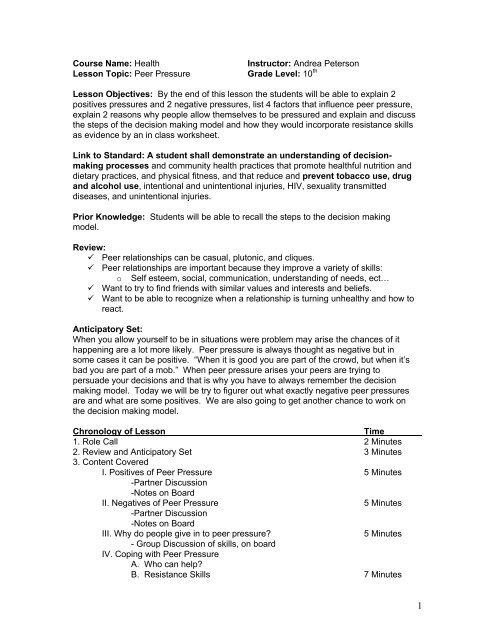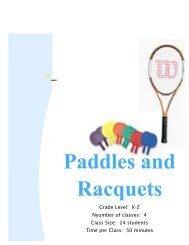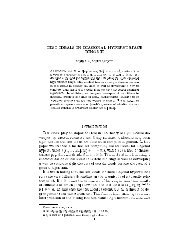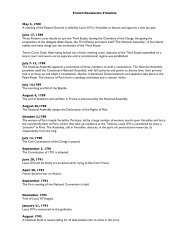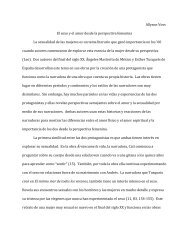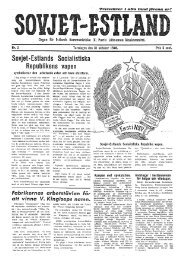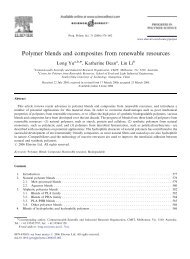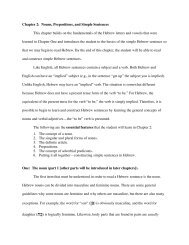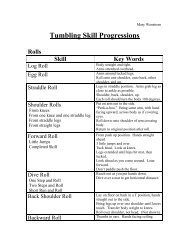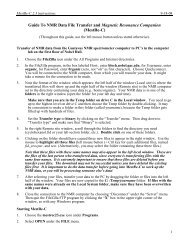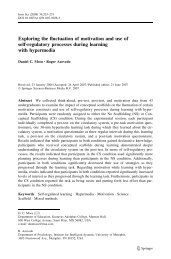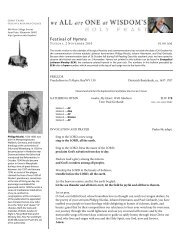Course Name: Health Instructor: Andrea Peterson Lesson Topic ...
Course Name: Health Instructor: Andrea Peterson Lesson Topic ...
Course Name: Health Instructor: Andrea Peterson Lesson Topic ...
Create successful ePaper yourself
Turn your PDF publications into a flip-book with our unique Google optimized e-Paper software.
<strong>Course</strong> <strong>Name</strong>: <strong>Health</strong> <strong>Instructor</strong>: <strong>Andrea</strong> <strong>Peterson</strong><br />
<strong>Lesson</strong> <strong>Topic</strong>: Peer Pressure Grade Level: 10 th<br />
<strong>Lesson</strong> Objectives: By the end of this lesson the students will be able to explain 2<br />
positives pressures and 2 negative pressures, list 4 factors that influence peer pressure,<br />
explain 2 reasons why people allow themselves to be pressured and explain and discuss<br />
the steps of the decision making model and how they would incorporate resistance skills<br />
as evidence by an in class worksheet.<br />
Link to Standard: A student shall demonstrate an understanding of decisionmaking<br />
processes and community health practices that promote healthful nutrition and<br />
dietary practices, and physical fitness, and that reduce and prevent tobacco use, drug<br />
and alcohol use, intentional and unintentional injuries, HIV, sexuality transmitted<br />
diseases, and unintentional injuries.<br />
Prior Knowledge: Students will be able to recall the steps to the decision making<br />
model.<br />
Review:<br />
Peer relationships can be casual, plutonic, and cliques.<br />
Peer relationships are important because they improve a variety of skills:<br />
o Self esteem, social, communication, understanding of needs, ect…<br />
Want to try to find friends with similar values and interests and beliefs.<br />
Want to be able to recognize when a relationship is turning unhealthy and how to<br />
react.<br />
Anticipatory Set:<br />
When you allow yourself to be in situations were problem may arise the chances of it<br />
happening are a lot more likely. Peer pressure is always thought as negative but in<br />
some cases it can be positive. “When it is good you are part of the crowd, but when it’s<br />
bad you are part of a mob.” When peer pressure arises your peers are trying to<br />
persuade your decisions and that is why you have to always remember the decision<br />
making model. Today we will be try to figurer out what exactly negative peer pressures<br />
are and what are some positives. We are also going to get another chance to work on<br />
the decision making model.<br />
Chronology of <strong>Lesson</strong> Time<br />
1. Role Call 2 Minutes<br />
2. Review and Anticipatory Set 3 Minutes<br />
3. Content Covered<br />
I. Positives of Peer Pressure 5 Minutes<br />
-Partner Discussion<br />
-Notes on Board<br />
II. Negatives of Peer Pressure 5 Minutes<br />
-Partner Discussion<br />
-Notes on Board<br />
III. Why do people give in to peer pressure? 5 Minutes<br />
- Group Discussion of skills, on board<br />
IV. Coping with Peer Pressure<br />
A. Who can help?<br />
B. Resistance Skills 7 Minutes<br />
1
-Group Discussion of skills, on board<br />
C. Decision Making Model 20 Minutes<br />
-Activity (Who’s fault is it?)<br />
-Group work for proper decision related to activity<br />
4. Closure 3 Minutes<br />
Closure: Nice job today class; make sure that you get your worksheets in to me by<br />
tomorrow if you did not finish. Today we did a lot with peer pressure and I hope that you<br />
learned a few more resistance skills today that you could use in your every day life.<br />
Next class period we are going to go into some of the characteristics of communication<br />
skills so that it will be easier to resist all that peer pressure, remember worksheets are<br />
due tomorrow and have great evening.<br />
Assessment of Objectives: Students will be given and in class worksheet that they are<br />
to complete and turn in by no later than the next class period, they will also get on a<br />
scale of 1 to 3 participation points for the day.<br />
List of Materials:<br />
Enough copies of story for entire class<br />
Work sheet on peer pressure and decision making<br />
NOTES<br />
A. “When your peers try to influence how you act to get you to do something”<br />
(Kids health, 2004, online).<br />
B. “When it is good, you are a member of the crowd; when it is bad, you are part<br />
of a mob” (Q&A, unknown, online).<br />
C. Positives (Merki, & Merki, 2003, 305) ON BOARD<br />
1. Examples set by someone your age.<br />
2. Influencing peers to take part in a positive act.<br />
3. Provide examples of what not to do.<br />
4. Influence to behave in positive ways (Meeks, Heit, & Page, 2005, 396<br />
D. Negatives (Merki, & Merki, 2003, 305) ON BOARD<br />
1. Unhealthy influences<br />
2. Shoplift<br />
3. Cut class<br />
4. Use drugs or alcohol<br />
5. Manipulation<br />
a. A sneaky or dishonest way to control or influence others.<br />
E. Why do people give in to “peer pressure” (Kids health, online)? ON<br />
BOARD<br />
1. Want to be liked or fit in.<br />
2. Worry about what others will think of them.<br />
3. Curious to try something new.<br />
4. The idea that “everyone is doing it” (Kids health, online).<br />
F. Coping with peer pressure<br />
1. Who can help with peer pressure? ON BOARD<br />
a. Parents<br />
b. Teachers<br />
c. Friends<br />
2
d. Counselors<br />
e. Coaches<br />
f. Ourselves<br />
2. “Resistance skills are skills are used to say no to an action or to leave<br />
a situation” (Meeks, Heit, & Page, 2005,131).<br />
a. How to use resistance skills (Meeks, Heit, & Page,<br />
2005,131). ON BOARD<br />
1) Say no with confidence.<br />
2) Give reasons for saying no.<br />
3) Repeat your no response several times.<br />
4) Use nonverbal to match verbal behavior.<br />
5) Avoid situations in which there will be pressure to make<br />
wrong decisions.<br />
6) Avoid people who make wrong decisions.<br />
7) Resist pressure to engage in illegal behavior<br />
3. Use Decision Making Model (Marzano, 1992)<br />
a. Step 1- Identify the decision to be made and state as a<br />
question.<br />
b. Step 2- Identify and describe options/choices.<br />
c. Step 3- Identify criteria for making decisions. (Values, Family)<br />
d. Step 4- Weigh each option/choice against criteria.<br />
e. Step 5- Make decision and explain reasoning.<br />
3
Activity Plan<br />
Content area: Peer Pressure <strong>Health</strong> Literacy: Effective Communication<br />
Critical thinking<br />
Grade Level: 10 th grade Infusion: Yes<br />
Activity Title: Who’s Fault is it? Inclusion: Yes<br />
Objectives for Activity: By the end of this activity the students will be able to list 4<br />
factors that influence peer pressure, explain 2 reasons why people allow themselves<br />
to be pressured and explain and discuss the steps of the decision making model as<br />
evidence by an in class worksheet.<br />
Material Needed: Copies for entire class of the story “It’s party time” and follow up<br />
worksheet.<br />
Time Allowed: 20-25 Minutes<br />
Descriptions and Directions for Activity:<br />
Directions:<br />
-The class will divide into small from of 3 to 4 people.<br />
-They will all receive a copy of the story “It’s Party Time” and will read it out loud.<br />
Everyone can read or on person but make sure to follow alone.<br />
-There are six characters in the story that need to be ranked for the responsibility of Maria<br />
smoking marijuana.<br />
-After they have all come to an agreement, one person from each group will come to the<br />
board and put their decisions on the bored.<br />
-Discuss why they ranked people where they did and peer pressure.<br />
-Go through some of the discussion questions.<br />
-Have groups go back to work, they will go through the decision making model to see<br />
what Maria really should have done in the situation.<br />
Discussion Questions<br />
-What were the main factors from the story that influenced your group’s rankings?<br />
-What resistance skills could Maria have used to say “no”?<br />
-What decisions did Maria make throughout the night that led her to using drugs?<br />
-Does anyone have a situation that they would like to share were they felt like they<br />
couldn’t say “no” and were pressured into doing something that didn’t want to do?<br />
-How about situations were you were positively pressured?<br />
Jackson, T. (1993). Activities That Teach. Pg. 223-227<br />
4
IT’S PARTY TIME<br />
Directions: As a group you will read this story out loud. One person can read it or you<br />
can take turns but make sure to follow along. There are six characters in the story. At<br />
the end of the story you are to determine who is the least responsible for Maria smoking<br />
a joint and who is the most responsible. On a scale, 1 would be the most responsible<br />
and 6 would be the least responsible. We will discuss as a class the results. Following<br />
the discussion you will go through the decision making model we use as a class to figure<br />
out what Maria should have done in her situation.<br />
Mark is sitting at his desk rolling marijuana joints. He plans on selling them at a<br />
big party he is having. His mom is going out of town for the weekend and since his<br />
parents are divorced, he will have the house to himself. Ever since the divorce, money<br />
has been tight and Mark has found that selling pot is an easy way to make the money he<br />
needs for college. He is a senior and wants to attend the local university in the fall.<br />
Unfortunately, Mark’s bedroom door is slightly open and when his mom sticks her<br />
head in to say good-bye she spots the marijuana in front of him. She tells him to get rid<br />
of that stuff immediately. She doesn’t want it in the house and tells him that it is<br />
dangerous and will fry his brain like an egg. Mark assures her that he will get rid of it<br />
and tells her not to worry because he never uses that stuff, he just sells it.<br />
That night Maria came to the party with Hector and a couple of girl friends, shelly<br />
and Nicole. After they have been there about an hour, someone shouts “The keg’s<br />
here!” and there is a mad rush for the kitchen. Maria doesn’t drink. She thinks it tastes<br />
awful. As a matter of fact, she didn’t even know that there was going to be booze at the<br />
party. Besides, her parents have said they would kill her if they ever catch her drinking<br />
or using drugs. However, Shelly and Nicole like to get a buzz so they keep after Maria<br />
to have at least one beer. Maria would like to go home, but Hector is so drunk he cant<br />
drive and she doesn’t dare call her parents for they fear they will find out she was at a<br />
beer bust.<br />
Around midnight, Mark brings out the marijuana joints and offers them for sale<br />
around the room. Maria’s friends pressure her to join them. To pressure her they ask,<br />
“What’s the matter, are you to good for us?” “Come on, you wouldn’t drink so the least<br />
you can do is join us in a smoke!” and “A real friend would give it a try!” Finally Maria<br />
gives in and goes with them out to the back porch where it is quieter. Just as Maria<br />
takes the joint and inhales, a spot light shines on the porch and they hear “Stand right<br />
where you are. This is the police and you are under arrest!”<br />
Please rank the individuals in this story from the person most responsible (1) for Maria<br />
having smoked the joint to the person least responsible (6). Be ready to give reasoning.<br />
Mark Shelly and Nicole<br />
Mark’s Mom Hector<br />
Maria Maria’s Parents<br />
Decision Making Model<br />
Step1- Identify the decision to be made and state as a question.<br />
Step 2- Identify and describe options/choices.<br />
Step 3- Identify criteria for making decisions. (Values, Family)<br />
Step 4- Weigh each option/choice against criteria.<br />
Step 5- Make decision and explain reasoning.<br />
5
Peer Pressure and Decision Making Model <strong>Name</strong><br />
List 4 factors that influence peer pressure.<br />
1.<br />
2.<br />
3.<br />
4.<br />
Explain 2 reasons why people allow themselves to be pressured.<br />
1.<br />
2.<br />
Please go through the Decision Making Model in regards to Maria and what she<br />
could have done to avoid the peer pressure.<br />
Step 1:<br />
Sep2:<br />
Step 3:<br />
Step 4:<br />
Step 5:<br />
6


